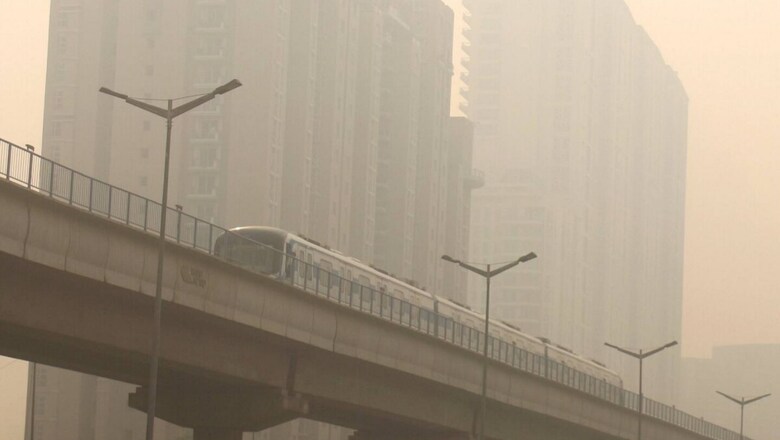
views
With deteriorating air quality in the national capital, lung-related complications have worsened and the Delhi government has decided to shut schools, colleges and other educational institutions till further orders.
The Arvind Kejriwal-led government has also decided to extend work-from-home for its employees till Sunday.
Here are 10 key points to know about as New Delhi, one of the world’s most polluted capitals, battles chronic winter smog.
1. Wednesday’s air quality index of 386 on a scale of 500 was a sign of “very poor” conditions that threaten respiratory illness on prolonged exposure, though it was off a “severe” reading of 499 earlier this month that showed even healthy people at risk.
17 NovAQI – 375 (301 to 400 – Very Poor)
PM10 – 373 (351 to 430 – Very Poor)
PM2.5 – 226 (121 to 250 – Very Poor) https://t.co/eyImUdJNtl
— Arvind Kejriwal (@ArvindKejriwal) November 17, 2021
Also Read: Delhi Pollution: SC Slams AAP Govt for ‘Passing the Buck’ to MCD, Warns of Expenditure Audit on Popularity Slogans
2. In view of high pollution levels in Delhi, the city’s Environment Minister Gopal Rai on Wednesday said his government has decided to shut schools, colleges and other educational institutions till further orders and extend the ban on construction and demolition activities till November 21. The Delhi government has also decided to extend work-from-home for its employees till Sunday.
3. The Delhi government will hire 1,000 private CNG buses to increase the public transport system as an emergency measure to curb vehicular pollution in the capital, Environment Minister Gopal Rai said. “1,000 private CNG buses will be hired to strengthen the public transport system. The process will start on Thursday. Schools, colleges, libraries, training centres will remain shut till further orders. We have banned the entry of trucks carrying non-essential items,” Rai said.
4. India stepped up efforts on Wednesday to combat high levels of pollution in New Delhi that threaten the lives of residents and others nearby, ordering a temporary halt to operations of five power stations and longer school closures. Delhi battles chronic winter smog each year as falling temperatures trap deadly pollutants from power plants outside it, along with fumes from vehicles and garbage burnt in the open. The order to temporarily shut five coal-fired power plants around New Delhi came from a panel of the federal environment ministry.
5. With an aim to further control vehicular pollution and dust, entry of trucks into Delhi, except those carrying essential commodities and tankers carrying petroleum products, is prohibited with immediate effect, till November 21 (or till further orders).
6. The issue regarding work from home for central government officers was considered but the total vehicles used for central government officers is not huge. So rather than implementing work from home we have issued an advisory for pooling and sharing of vehicles,” a Supreme Court bench was told. The Centre suggested 50 per cent attendance in offices of the Government of National Capital Territory of Delhi (GNCTD).
7. The Supreme Court on Tuesday said that the government must persuade farmers against stubble burning. The court stressed that it does not want to punish them while Delhi and neighbouring cities see an escalating air quality crisis. “We do not want to penalise the farmers. We have already asked the centre to pursue and request those farmers to not burn stubble at least for a week,” Chief Justice NV Ramana said. “Irrespective of figures in affidavits, we have to consider the plight of the farmers…what compels him to burn the stubble? Nobody is concerned about that. People sleeping in five-star hotels in Delhi blame farmers. Look at such small landholdings. Can they afford the machines you all talk about?” he added.
8. On Monday, the central government had told the Supreme Court that farm fires have only 10 per cent share in the national capital’s severe pollution, contradicting the statement of Delhi government, which has blamed the stubble burning for the alarming pollution levels in the capital.
9. The Delhi Traffic Police has intensified its crackdown against pollution violators and those still plying old vehicles with deployment of teams at 170 locations across the city, officials said on Sunday.
10. A report states that the summer capital Shimla has the cleanest air in Himachal. At the same time, the AQI of Baddi, the industrial town of Himachal Pradesh, has been registered at 109. Owing to poor quality air in Delhi and surrounding areas, a large number of tourists are turning to Himachal. According to Himachal Pollution Control Board, AQI level in Shimla is 40, Manali is at 82, Dharamsala has 43, Sundernagar at 50, Una 57, Damdal 53, Parwanoo 45, Paonta Sahib 86, Kala Amb 57, and at Nalagarh, the pollution level is 80.
Read all the Latest India News here



















Comments
0 comment